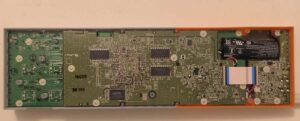It doesn’t cost anything to window shop!
With the holiday selling season in full swing, I took another look at Yamaha Seqtrak. Ya never know when a bargain might present itself, so it’s good to be ready. 🙂
Seqtrak is Yamaha’s low cost alternative to the all-in-one Teenage Engineering OP-1 — a battery-powered synthesizer, sampler and sequencer. The price is much sweeter, $399 USD (MAP/street), than Teenage Engineering.
I’ve been hesitant to chomp on Seqtrak because I don’t really need a groove box. Yeah, it might provide fun occasionally, but it doesn’t really fulfill a need for what I play live (mainly keyboard emulation of acoustic instruments).
A few postings on Yamaha Musicians Forum motivated me to investigate further, however. Seqtrak implements two forms of synthesis: AWM2 and FM. At first, the AWM2 support sounds like a yawner. Guess what? The AWM2 sound set is pretty much the Motif XF (MOXF) factory sounds! That ain’t chopped liver.
The Seqtrak DX FM implementation is the same as the Reface DX. Even though it’s a four-OP implementation, feedback is supported on any OP, yielding a harmonically richer sound than four-OP of yesteryear. Both DX FM and AWM2 synths can be routed into a robust collection of DSP effects, including rotary speaker, VCM effects and HD reverb.
I wish the Seqtrak DX FM editor supported the Reface DX. It is one nice editor.
Thus, $399 buys a three channel (two synth, one DX FM) battery-powered MIDI module supporting DX FM and Motif XF synthesis. That’s quite a bargain when Reface DX alone costs $400 or so on a typical day.
As an expander, my main quibble is usage model. Seqtrak does not have a display showing the currently selected voice. I can’t tolerate that level of uncertainty during a live performance. The Seqtrak app controls all, but it means schlepping another piece (iPad) to the gig and making everything work live.
Still, it’s enticing. A case of want over need.
Seqtrak inside
What’s inside that tiny box? Thanks to a brave soul on LoopyPro, we get the picture.
Seqtrak consists of three printed circuit boards (PCB): a front panel board which runs most of the length of the chassis, a large digital electronics board mounted in parallel with the front panel board, and a small analog electronics board near the battery and speaker. The analog electronics board has connectors for USB-C, PHONES, AUDIO IN and MIDI.
The main event is the digital electronics board, usually called “DM” in Yamaha-speak. In this picture, we are looking at the bottom of the board. The top of the board — sometimes called the “component side” — is obviously out of view. The three large rectangular integrated circuits (IC) are SDRAM (e.g., Winbond W9825G6KH-6 256Mbit Parallel 166 MHz, typically organized as 32MBytes). The specially labelled IC is (likely) a Winbond 256Mbit (32MByte) NOR flash ROM containing the Seqtrak code.
The memory ICs surround the foil pattern for a Yamaha proprietary SWX processor. I’m guessing SWX09 or SWX10. SWX combines an ARM core with AWM2 tone generation and DSP effect processors. Seqtrak implements DX FM because only SWP70 implements FM-X. Low cost devices like Seqtrak usually employ a single, highly integrated SWX and do not include a separate SWP70 tone generator.
There may be additional memory devices on the component side of the DM board. The battery is a 3.6V 2100mAh Li-ion battery.
Copyright © 2024 Paul J. Drongowski

